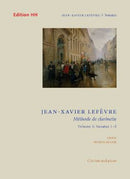| 作曲者 | Jean-Xavier Lefèvre (1763-1829) |
| タイトル | Methode de clarinette Vol. 1 |
| 出版社 | Edition HH Limited |
| 楽器編成 | clarinet and piano |
| 品番 | 979-0708185543 |
| 校訂者 | Nicholas Cox |
| 形状 | 100 g |
| 出版番号 | HH539FSP |
| ISMN | 979-0708185543 |
| ISBN | 978-1-914137-11-2 |
| サンプル | https://www.editionhh.co.uk/Notenbeispiel/HH 539_look_inside.pdf |
These Sonatas were written as part of Jean-Xavier Lefèvre’s Méthode for the Clarinet. The first five Sonatas are suitable for clarinettists who have been studying for two to three years and are working towards Grade IV or V(ABRSM) and have a good grasp of the chalumeau and clarino registers up to top D6. The styles are all classical, ranging from Allegros in 2 or 4 to sprightly or pastoral Rondeaux (often spelt the French way) and from Polonaise in 3 to heartfelt Adagios. They introduce figuration, syncopations and ornamentation gradually and include a varied range of rudimentary classical articulation. As Lefèvre was writing for the much lighter 18th Century 5 or 6 key boxwood clarinet, younger students may find some movements taxing to play on the modern instrument. Players should therefore take enough time to breathe between and at the ends of phrases. I have suggested breath marks throughout. Occasionally, you may even have to leave a note out to breathe. These Sonatas are great stepping stones to the more difficult clarinet master works by Mozart and Weber and are also invaluable first pieces for those studying period performance on the classical clarinet. They retain Lefèvre’s original notation for clarinet and the bass lines are transposed down a tone so the Sonatas are playable on the B flat clarinet. The right hand of the piano parts have been realised from a single unfigured bass line probably intended for the cello. The piano parts are designed to be stylistic, complementary to the clarinet line, satisfying to play and occasionally challenging. This edition includes an Introduction in English and German as well as Notes on Editorial Method and Performance Notes for each Sonata at the back of the piano score.



